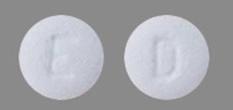Slynd Disease Interactions
There are 2 disease interactions with Slynd (drospirenone).
Drospirenone (applies to Slynd) hyperkalemia
Major Potential Hazard, Moderate plausibility. Applicable conditions: Adrenal Insufficiency, Renal Dysfunction, Liver Disease
The progestin drospirenone (DRSP) has antialdosterone activity, including the potential for hyperkalemia in high-risk patients. The use of DRSP-containing combination hormone is contraindicated in patients with conditions that predispose to hyperkalemia (renal impairment, hepatic impairment, and adrenal insufficiency). Use caution when prescribing these agents to women who regularly take other medications that can increase potassium, such as nonsteroidal anti-inflammatory drugs (NSAIDs), potassium-sparing diuretics, potassium supplements, angiotensin converting enzyme (ACE) inhibitors, angiotensin-II receptor antagonists, heparin and aldosterone antagonists. It is recommended to monitor serum potassium concentrations during the first month of dosing in high-risk patients who take strong CYP3A4 inhibitors long-term and concomitantly.
References
- (2001) "Product Information. Yasmin (drospirenone-ethinyl estradiol)." Berlex Laboratories
- (2005) "Product Information. Angeliq (drospirenone-estradiol)." Berlex Laboratories
- (2010) "Product Information. Beyaz (drospirenone/ethinyl estradiol/levomefolate)." Bayer Pharmaceutical Inc
Estrogens/progestogens (applies to Slynd) retinal thrombosis
Moderate Potential Hazard, Moderate plausibility. Applicable conditions: Visual Defect/Disturbance
Estrogens and progestogens may cause retinal thrombosis. Oral contraceptives should be discontinued if there is unexplained partial or complete loss of vision; onset of proptosis or diplopia; papilledema; or retinal vascular lesions. Therapy with these agents should be administered cautiously in patients who have preexisting ocular problems and appropriate diagnostic and therapeutic measures should be instituted. Contact lens wearers who develop visual changes or changes in lens tolerance should be assessed by an ophthalmologist.
References
- "Product Information. Ortho-Novum 1/35 (ethinyl estradiol-norethindrone)." Ortho McNeil Pharmaceutical
- "Product Information. Ortho-Novum 10/11 (ethinyl estradiol-norethindrone)." Ortho McNeil Pharmaceutical
- (2001) "Product Information. Ortho-Cept (desogestrel-ethinyl estradiol)." Ortho McNeil Pharmaceutical
- "Product Information. Demulen 1/50 (ethinyl estradiol-ethynodiol)." Searle
- (2001) "Product Information. Triphasil (ethinyl estradiol-levonorgestrel)." Wyeth-Ayerst Laboratories
- (2001) "Product Information. Ortho-Cyclen (ethinyl estradiol-norgestimate)." Ortho McNeil Pharmaceutical
- (2001) "Product Information. Lo/Ovral (ethinyl estradiol-norgestrel)." Wyeth-Ayerst Laboratories
- "Product Information. Ortho-Novum 1/50 (mestranol-norethindrone)." Ortho McNeil Pharmaceutical
- (2001) "Product Information. Norplant System (levonorgestrel)." Wyeth-Ayerst Laboratories
- (2001) "Product Information. Micronor (norethindrone)." Ortho McNeil Pharmaceutical
- (2001) "Product Information. Ovrette (norgestrel)." Wyeth-Ayerst Laboratories
- (2001) "Product Information. Prometrium (progesterone)." Virtus Pharmaceuticals LLC
- (2021) "Product Information. Nextstellis (drospirenone-estetrol)." Mayne Pharma
Slynd drug interactions
There are 341 drug interactions with Slynd (drospirenone).
Slynd alcohol/food interactions
There is 1 alcohol/food interaction with Slynd (drospirenone).
More about Slynd (drospirenone)
- Slynd consumer information
- Check interactions
- Compare alternatives
- Pricing & coupons
- Reviews (358)
- Drug images
- Side effects
- Dosage information
- During pregnancy
- FDA approval history
- Drug class: progestins
- Breastfeeding
- En español
Related treatment guides
Drug Interaction Classification
| Highly clinically significant. Avoid combinations; the risk of the interaction outweighs the benefit. | |
| Moderately clinically significant. Usually avoid combinations; use it only under special circumstances. | |
| Minimally clinically significant. Minimize risk; assess risk and consider an alternative drug, take steps to circumvent the interaction risk and/or institute a monitoring plan. | |
| No interaction information available. |
Further information
Always consult your healthcare provider to ensure the information displayed on this page applies to your personal circumstances.


